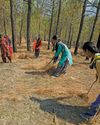
SAUBHAGYA MISHRA, who works for an outsourcing major in Karnataka's capital city Bengaluru, manages distribution mechanism for many water utilities in Australia and the US. "I have coded flawless mechanism to deliver water to thousands of houses thousands of kilometres away from here. But in February, I got a notice from my apartment management informing complete cessation of water supply. This was a first for me," he says. "Without water, what supply solution can one think of?" he says.
In mid-March, Mishra sent his wife and daughter to their hometown Lucknow, Uttar Pradesh. With the family gone, he could bring down water use by two-thirds. He somehow procures 10-15 litres of "mineral water" from a vendor daily that he uses for all purposes. But he has worries: "How long the crisis would continue? More importantly, why did it happen?"
India's prime information-technology hub and the country's third most populated city, Bengaluru is facing its worst water shortage. On March 18, after a high-level meeting on the crisis, Karnataka Chief Minister Siddaramaiah told the media that the city was facing a water shortage of 500 million litres per day (MLD) against a daily demand of 2,600 MLD. Of the 14,000 government-registered borewells in Bengaluru, some 6,900 had dried, said Siddaramaiah.
A total of 257 areas in the city have been identified as water stressed. Besides, 55 of 110 villages under the Bruhat Bengaluru Mahanagara Palike (BBMP) face water crisis.
A week before, on March 12, the Bangalore Water Supply and Sewerage Board (BWSSB) reduced water supply to major consumers companies, hospitals, railways and airports in the city by 20 per cent. Previously, it had been supplying them 95-100 per cent of their allotted quota of water.
Bu hikaye Down To Earth dergisinin April 01, 2024 sayısından alınmıştır.
Start your 7-day Magzter GOLD free trial to access thousands of curated premium stories, and 9,000+ magazines and newspapers.
Already a subscriber ? Giriş Yap
Bu hikaye Down To Earth dergisinin April 01, 2024 sayısından alınmıştır.
Start your 7-day Magzter GOLD free trial to access thousands of curated premium stories, and 9,000+ magazines and newspapers.
Already a subscriber? Giriş Yap

THE CIRCULARITY ARGUMENT
A circular economy can help India achieve its developmental aspirations while following the low-carbon pathway. It will also help address the challenges of waste management, pollution and overexploitation of natural resources. Industries are already innovating to reuse high-volume wastes and have shown that the transition can usher in both environmental and financial windfalls

Banking on flawed drug voluntary licences
The Medicines Patent Pool is pushing for more VLs, but its bad deal with Novartis on a cancer drug shows the pitfalls

Lasting solutions
For the first time, the UN has recognised the role of indigenous communities in tackling aridity. A repository of traditional knowledge India has the wherewithal to lead the way

IMD at 150
India's journey into modern weather forecasting took a decisive turn 150 years ago with the establishment of India Meteorological Department during the British rule. The agency has come a long way since then, shaping the way the country predicts and responds to its diverse climate challenges

Every drop counts
In drought-prone Marathwada region, 14 villages have managed to counter water shortage by budgeting the resource

Threat to survival
Hollongapar Gibbon Sanctuary in Assam faces ecological challenges as railway electrification and hydrocarbon exploration endanger its fragile biodiversity

'Migration is going to be a battlefield'
AMITAV GHOSH is one of the foremost chroniclers of our times. His literary sojourn includes writings on topics that range from languages to climate change to human lives. His latest book, Wild Fictions, brings some of his works on these issues under one title. In a conversation with RAJAT GHAI, Ghosh shares his views on the future of human movement. Excerpts:

Face of future
California wildfires confirm forest fires are intensifying in a hotter world, emitting substantial amounts of greenhouse gases and reinforcing global warming

Friends of the forest
Residents of 30 villages in Uttarakhand establish a model for public participation in saving forests from wildfires

Climate-crazy playbook
Just hours after his second (and final) term began on January 20, US President Donald Trump unleashed 46 presidential actions. Several of these are centred on the US' climate commitments, energy transition, migration and trade policies, and are likely to have negative global implications